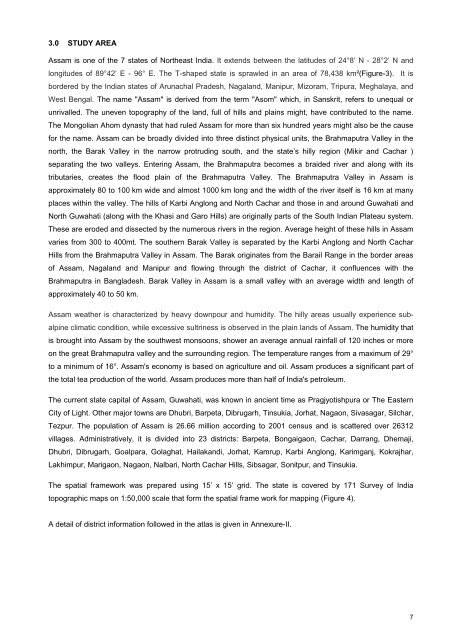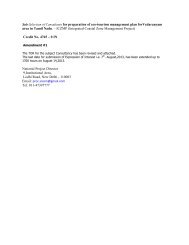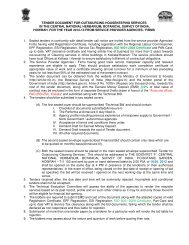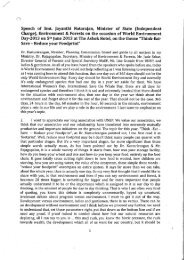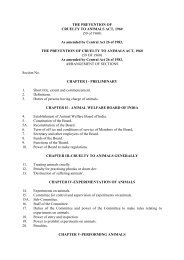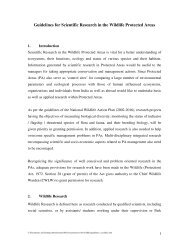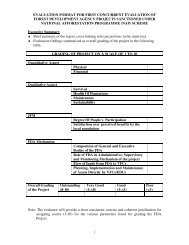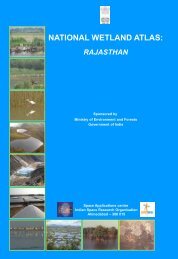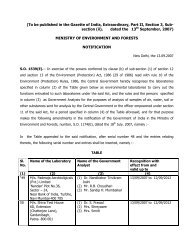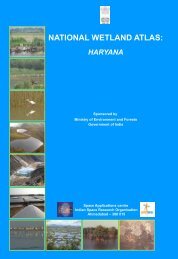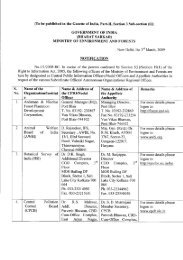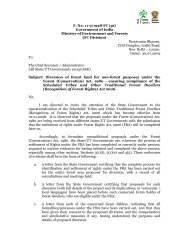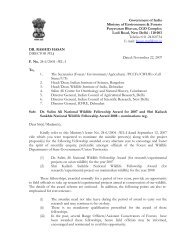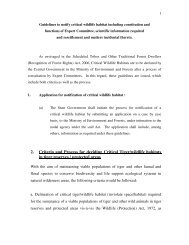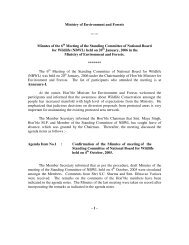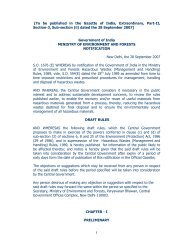Assam - Ministry of Environment and Forests
Assam - Ministry of Environment and Forests
Assam - Ministry of Environment and Forests
Create successful ePaper yourself
Turn your PDF publications into a flip-book with our unique Google optimized e-Paper software.
3.0 STUDY AREA<strong>Assam</strong> is one <strong>of</strong> the 7 states <strong>of</strong> Northeast India. It extends between the latitudes <strong>of</strong> 24°8’ N - 28°2’ N <strong>and</strong>longitudes <strong>of</strong> 89°42’ E - 96° E. The T-shaped state is sprawled in an area <strong>of</strong> 78,438 km²(Figure-3). It isbordered by the Indian states <strong>of</strong> Arunachal Pradesh, Nagal<strong>and</strong>, Manipur, Mizoram, Tripura, Meghalaya, <strong>and</strong>West Bengal. The name "<strong>Assam</strong>" is derived from the term "Asom" which, in Sanskrit, refers to unequal orunrivalled. The uneven topography <strong>of</strong> the l<strong>and</strong>, full <strong>of</strong> hills <strong>and</strong> plains might, have contributed to the name.The Mongolian Ahom dynasty that had ruled <strong>Assam</strong> for more than six hundred years might also be the causefor the name. <strong>Assam</strong> can be broadly divided into three distinct physical units, the Brahmaputra Valley in thenorth, the Barak Valley in the narrow protruding south, <strong>and</strong> the state’s hilly region (Mikir <strong>and</strong> Cachar )separating the two valleys. Entering <strong>Assam</strong>, the Brahmaputra becomes a braided river <strong>and</strong> along with itstributaries, creates the flood plain <strong>of</strong> the Brahmaputra Valley. The Brahmaputra Valley in <strong>Assam</strong> isapproximately 80 to 100 km wide <strong>and</strong> almost 1000 km long <strong>and</strong> the width <strong>of</strong> the river itself is 16 km at manyplaces within the valley. The hills <strong>of</strong> Karbi Anglong <strong>and</strong> North Cachar <strong>and</strong> those in <strong>and</strong> around Guwahati <strong>and</strong>North Guwahati (along with the Khasi <strong>and</strong> Garo Hills) are originally parts <strong>of</strong> the South Indian Plateau system.These are eroded <strong>and</strong> dissected by the numerous rivers in the region. Average height <strong>of</strong> these hills in <strong>Assam</strong>varies from 300 to 400mt. The southern Barak Valley is separated by the Karbi Anglong <strong>and</strong> North CacharHills from the Brahmaputra Valley in <strong>Assam</strong>. The Barak originates from the Barail Range in the border areas<strong>of</strong> <strong>Assam</strong>, Nagal<strong>and</strong> <strong>and</strong> Manipur <strong>and</strong> flowing through the district <strong>of</strong> Cachar, it confluences with theBrahmaputra in Bangladesh. Barak Valley in <strong>Assam</strong> is a small valley with an average width <strong>and</strong> length <strong>of</strong>approximately 40 to 50 km.<strong>Assam</strong> weather is characterized by heavy downpour <strong>and</strong> humidity. The hilly areas usually experience subalpineclimatic condition, while excessive sultriness is observed in the plain l<strong>and</strong>s <strong>of</strong> <strong>Assam</strong>. The humidity thatis brought into <strong>Assam</strong> by the southwest monsoons, shower an average annual rainfall <strong>of</strong> 120 inches or moreon the great Brahmaputra valley <strong>and</strong> the surrounding region. The temperature ranges from a maximum <strong>of</strong> 29°to a minimum <strong>of</strong> 16°. <strong>Assam</strong>'s economy is based on agriculture <strong>and</strong> oil. <strong>Assam</strong> produces a significant part <strong>of</strong>the total tea production <strong>of</strong> the world. <strong>Assam</strong> produces more than half <strong>of</strong> India's petroleum.The current state capital <strong>of</strong> <strong>Assam</strong>, Guwahati, was known in ancient time as Pragjyotishpura or The EasternCity <strong>of</strong> Light. Other major towns are Dhubri, Barpeta, Dibrugarh, Tinsukia, Jorhat, Nagaon, Sivasagar, Silchar,Tezpur. The population <strong>of</strong> <strong>Assam</strong> is 26.66 million according to 2001 census <strong>and</strong> is scattered over 26312villages. Administratively, it is divided into 23 districts: Barpeta, Bongaigaon, Cachar, Darrang, Dhemaji,Dhubri, Dibrugarh, Goalpara, Golaghat, Hailak<strong>and</strong>i, Jorhat, Kamrup, Karbi Anglong, Karimganj, Kokrajhar,Lakhimpur, Marigaon, Nagaon, Nalbari, North Cachar Hills, Sibsagar, Sonitpur, <strong>and</strong> Tinsukia.The spatial framework was prepared using 15’ x 15’ grid. The state is covered by 171 Survey <strong>of</strong> Indiatopographic maps on 1:50,000 scale that form the spatial frame work for mapping (Figure 4).A detail <strong>of</strong> district information followed in the atlas is given in Annexure-II.7


